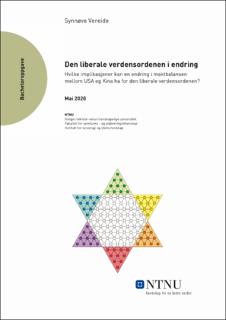| dc.contributor.advisor | Ellinggard, Kristian | |
| dc.contributor.author | Vereide, Synnøve | |
| dc.date.accessioned | 2020-07-07T16:02:49Z | |
| dc.date.available | 2020-07-07T16:02:49Z | |
| dc.date.issued | 2020 | |
| dc.identifier.uri | https://hdl.handle.net/11250/2661074 | |
| dc.description.abstract | Denne bacheloroppgavens tema er den såkalte liberale verdensordenen sett i lys av relative endringer i maktbalansen. Forskningsspørsmålet lyder slik: Hvordan har maktbalansen mellom Kina og USA endret seg de siste 50 årene, og hvilke implikasjoner kan dette ha for den liberale verdensordenen?
Metodisk har jeg tatt i bruk tallgrunnlag fra kilder som Stockholm International Peace Research Institute, European Intelligence Unit, Verdensbanken og Statista. Dette for å komparativt analysere maktkapabilitetene til Kina og USA. Fokuset ligger på intern maktbalansering, samt hard og myk makt. Teoretisk ligger tyngdepunktet på Gilpins teori fra 1981 om hegemonens kostnader versus fordeler, og Kissingers realpolitiske teori fra hans bok World Order (2014).
Til slutt konkluderes det overordnet med at garantisten for den eksisterende ordenen (USA) med tiden vil få svakere insentiver til å opprettholde status quo (vår liberale verdensorden), mens en voksende stormakt (Kina) vil få sterkere insentiver til å utfordre status quo. Dette er oppgavens hovedfunn. Mer spesifikt konkluderes det med at deler av den såkalte liberale verdensordenen kan bli utfordret i tiden som kommer, men at dette ikke utelukkende skyldes Kinas fremvekst, men i stor grad også kan forklares med amerikansk tilbaketrekking. Det argumenteres dessuten for at denne maktbalansen først har endret seg gradvis siden 70-tallet, og deretter raskere etter at Donald Trump ble innsatt som president i 2016. Det argumenteres dessuten for at pandemien COVID-19 kan vise seg å ytterligere fremskynde endringer i maktbalansen og i den liberale verdensordenen. | |
| dc.description.abstract | This bachelor thesis’ theme is the so-called liberal world order with respect to relative shifts in the power balance. The research question is as follows: “How has the power balance between the U.S and China changed the last 50 years and what implications can this have for the liberal world order. “
Methodically, numerical evidence from sources such as the Stockholm International Peace Research Institute, European Intelligence Unit, The World Bank and Statista was used to comparatively analyse the power capabilities of the U.S and China. The focus has been on internal power-balancing, as well as hard and soft power. The theoretical foundations for this thesis is Gilpin's theory from 1981 about the hegemon's costs versus benefits, as well as Kissinger's theory of Realpolitik presented in “World Order”.
Finally it is concluded that the guarantor of the existing world order (The U.S) with time will have weaker incentives to maintain the status quo of the liberal world order while a growing superpower in China will have a stronger incentive to challenge this status quo. This is the main finding of the thesis. More specifically it is concluded that parts of the liberal world order can be challenged in the time ahead, but that this is not solely to blame on China’s advancement, but to a significant degree also american withdrawal. It’s argued that this power balance first has shifted slowly since the 70’s but then sped up after the inauguration of Donald Trump in 2016. It is also argued that the pandemic COVID-19 can further accelerate shifts in the power balance and in the liberal world order. | |
| dc.publisher | NTNU | |
| dc.title | Den liberale verdensordenen i endring | |
| dc.type | Bachelor thesis | |
